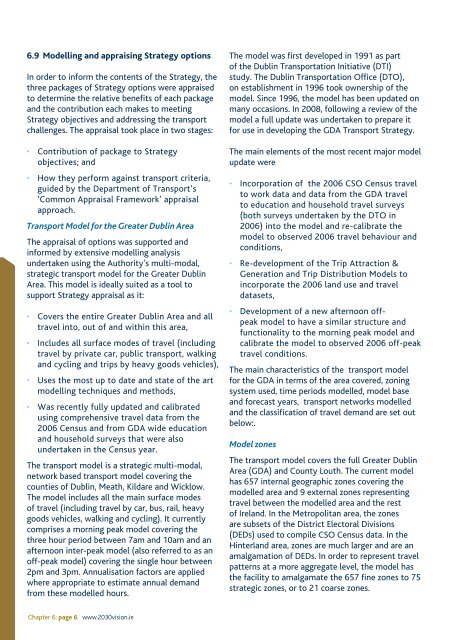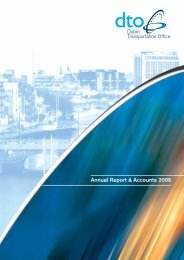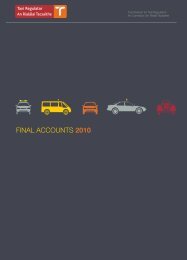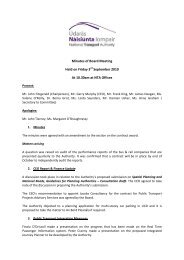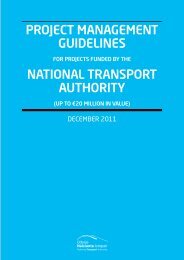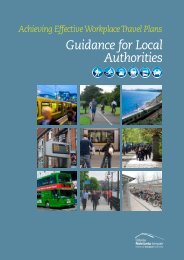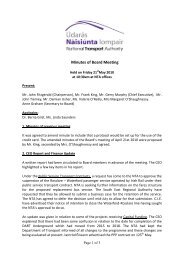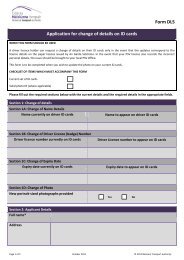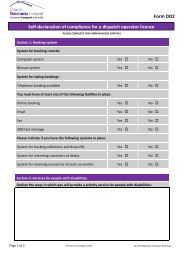Greater Dublin Area Draft Transport Strategy 2011-2030
Greater Dublin Area Draft Transport Strategy 2011-2030
Greater Dublin Area Draft Transport Strategy 2011-2030
- No tags were found...
You also want an ePaper? Increase the reach of your titles
YUMPU automatically turns print PDFs into web optimized ePapers that Google loves.
6.9 Modelling and appraising <strong>Strategy</strong> optionsIn order to inform the contents of the <strong>Strategy</strong>, thethree packages of <strong>Strategy</strong> options were appraisedto determine the relative benefits of each packageand the contribution each makes to meeting<strong>Strategy</strong> objectives and addressing the transportchallenges. The appraisal took place in two stages:• Contribution of package to <strong>Strategy</strong>objectives; and• How they perform against transport criteria,guided by the Department of <strong>Transport</strong>’s‘Common Appraisal Framework’ appraisalapproach.<strong>Transport</strong> Model for the <strong>Greater</strong> <strong>Dublin</strong> <strong>Area</strong>The appraisal of options was supported andinformed by extensive modelling analysisundertaken using the Authority’s multi-modal,strategic transport model for the <strong>Greater</strong> <strong>Dublin</strong><strong>Area</strong>. This model is ideally suited as a tool tosupport <strong>Strategy</strong> appraisal as it:• Covers the entire <strong>Greater</strong> <strong>Dublin</strong> <strong>Area</strong> and alltravel into, out of and within this area,• Includes all surface modes of travel (includingtravel by private car, public transport, walkingand cycling and trips by heavy goods vehicles),• Uses the most up to date and state of the artmodelling techniques and methods,• Was recently fully updated and calibratedusing comprehensive travel data from the2006 Census and from GDA wide educationand household surveys that were alsoundertaken in the Census year.The transport model is a strategic multi-modal,network based transport model covering thecounties of <strong>Dublin</strong>, Meath, Kildare and Wicklow.The model includes all the main surface modesof travel (including travel by car, bus, rail, heavygoods vehicles, walking and cycling). It currentlycomprises a morning peak model covering thethree hour period between 7am and 10am and anafternoon inter-peak model (also referred to as anoff-peak model) covering the single hour between2pm and 3pm. Annualisation factors are appliedwhere appropriate to estimate annual demandfrom these modelled hours.The model was first developed in 1991 as partof the <strong>Dublin</strong> <strong>Transport</strong>ation Initiative (DTI)study. The <strong>Dublin</strong> <strong>Transport</strong>ation Office (DTO),on establishment in 1996 took ownership of themodel. Since 1996, the model has been updated onmany occasions. In 2008, following a review of themodel a full update was undertaken to prepare itfor use in developing the GDA <strong>Transport</strong> <strong>Strategy</strong>.The main elements of the most recent major modelupdate were• Incorporation of the 2006 CSO Census travelto work data and data from the GDA travelto education and household travel surveys(both surveys undertaken by the DTO in2006) into the model and re-calibrate themodel to observed 2006 travel behaviour andconditions,• Re-development of the Trip Attraction &Generation and Trip Distribution Models toincorporate the 2006 land use and traveldatasets,• Development of a new afternoon offpeakmodel to have a similar structure andfunctionality to the morning peak model andcalibrate the model to observed 2006 off-peaktravel conditions.The main characteristics of the transport modelfor the GDA in terms of the area covered, zoningsystem used, time periods modelled, model baseand forecast years, transport networks modelledand the classification of travel demand are set outbelow:.Model zonesThe transport model covers the full <strong>Greater</strong> <strong>Dublin</strong><strong>Area</strong> (GDA) and County Louth. The current modelhas 657 internal geographic zones covering themodelled area and 9 external zones representingtravel between the modelled area and the restof Ireland. In the Metropolitan area, the zonesare subsets of the District Electoral Divisions(DEDs) used to compile CSO Census data. In theHinterland area, zones are much larger and are anamalgamation of DEDs. In order to represent travelpatterns at a more aggregate level, the model hasthe facility to amalgamate the 657 fine zones to 75strategic zones, or to 21 coarse zones.Chapter 6: page 6 www.<strong>2030</strong>vision.ie


